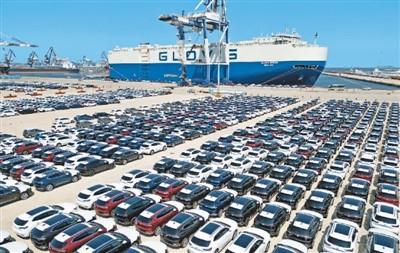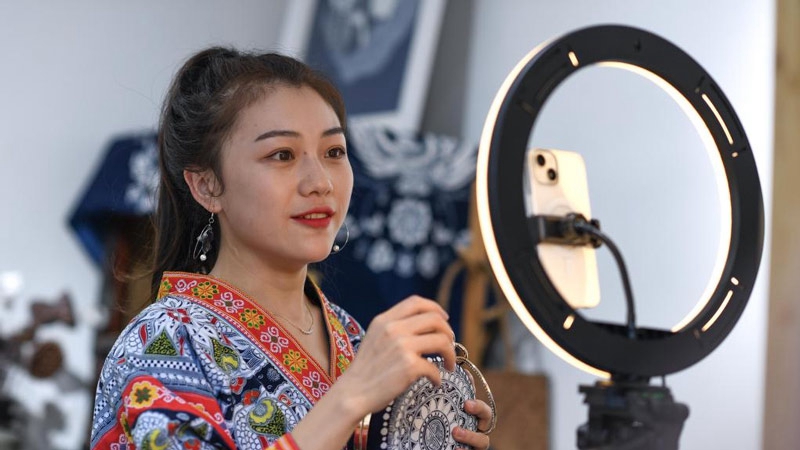China's worldwide exports of domestically-produced new energy vehicles shows sound growth momentum
China's exports of new energy vehicles (NEVs) have maintained a sound growth momentum since the beginning of this year.

Photo shows vehicles that are about to be shipped overseas at the port of Yantai in east China's Shandong Province, Aug. 17, 2022. (Photo/Tang Ke)
The country's NEV exports increased 1.3 times year-on-year to 202,000 units in the first half of this year, accounting for 16.6 percent of its total exports of automobiles, according to statistics released by the China Association of Automobile Manufacturers (CAAM). In July, China exported 54,000 NEVs, registering a year-on-year growth of 37.6 percent.
NEV exports by foreign-funded enterprises and joint ventures in China accounted for about two-thirds of the country's total NEV exports, according to Xu Haidong, deputy chief engineer at the CAAM.
In the first six months of 2022, Tesla's Shanghai Gigafactory exported nearly 100,000 NEVs, more than double the amount exported in the same period last year. Tesla China exported its high-quality NEVs to developed regions and countries such as Europe, Australia, Japan, and Singapore, all despite the dual pressures of the COVID-19 pandemic and ongoing global supply chain crisis, said an executive of Tesla.
Meanwhile, Chinese auto brands have accelerated their global expansion. Data from the China Passenger Car Association (CPCA) showed that China's leading NEV manufacturer BYD exported 2,177 NEV passenger cars in June this year.
In August, BYD and Great Wall Motors (GWM), another leading electric vehicle manufacturer in China, announced their foray into the European NEV market.
"Exports to Western Europe reached 34 percent of China's total exports of NEV passenger cars in the first half of this year. During the same period, Belgium was the biggest importer of China's NEVs," said Cui Dongshu, secretary-general of the CPCA.
Chinese carmakers are expanding their footprints in the overseas market. GWM has introduced its Ora electric vehicles to the Thai market. The company will also launch its Ora electric vehicles in the UK, Australia, South Africa, and Malaysia in the future.
As of August, BYD's pure-electric buses and taxis have been exported to more than 70 countries and regions. BYD plans to further explore markets in the Middle East, Africa, Europe, and the Asia Pacific region this year.

Photo shows a batch of Tang electric vehicles produced by Chinese electric vehicle manufacturer BYD that are about to be shipped overseas to Norway. (Photo courtesy of BYD)
NEVs have become the highlight for China's exported vehicles in recent years. Last year, China exported 310,000 NEVs, up about 304.6 percent from the previous year.
Xu said that the high growth rate of China's NEV exports is an inevitable result of years of efforts made by the country's domestic NEV sector. During the past decade, China has rolled out supportive policies to promote the development of its NEV industry. Chinese carmakers have meanwhile strived to improve the NEV sector's comprehensive strengths, managing to meet diversified market demand from across the world.
After more than 20 years of efforts, BYD has mastered core technologies in components such as motors, electrical batteries and chips in terms of NEV passenger cars, all while accumulating rich experience, according to an executive at the company.
The executive added that BYD has served over 2.1 million owners of NEV passenger vehicles and its NEVs have moreover been well received in the market, which has enabled the company to continue striding forward in its exploration of overseas markets.
China's mature manufacturing capabilities, coupled with its efficient and cost-effective production systems, guarantee the sound production of NEVs domestically and underscore the country’s advantages as a low-cost producer in the global market.
While the production capacities of automakers in Europe, the U.S. and Japan have been cut due to chip and battery shortages, Chinese carmakers have effectively coped with the chip shortages while reporting robust growth in its domestically-produced NEVs, Cui said.
In addition, considerable demand for NEVs across the world has created wide prospects for China's NEV exports moving forward. Cui explained that the switch to NEVs from cars powered with fossil fuels in the auto industry, in addition to the steep rise in oil prices, have lured a larger number of potential car buyers in many countries to choose NEVs.
In recent years, multiple European countries have promoted the wider use of NEVs by rolling out preferential policies such as additional purchasing subsidies and lower import duties, which has opened up a window of opportunity for China's NEV exports.
China has formed a relatively complete NEV industrial chain, and its NEV exports are expected to maintain rapid growth in the years ahead, according to Cui.
To better help Chinese NEVs go global, Chinese auto manufacturers should further improve the competitiveness of their auto products, increase their research and development spending, and enhance their independent innovation capabilities, Xu added.
Xu also mentioned that Chinese automakers should further adapt to local market conditions while understanding local cultures and consumer demands in different countries and regions.
Photos
Related Stories
- China's passenger car sales down, but new-energy sector thrives
- China’s new energy vehicle market embraces sound momentum for development
- New energy vehicles enhance China's status in global auto industry
- 107 Chinese cities issue special plates for new energy vehicles
- China's new energy vehicle sales surge in May
- China to see "handsome growth" in 2017 NEV sales
- Reduction of subsidies beneficial to new energy vehicle industry, experts say
- Volkswagen showcases new energy vehicles in Beijing
- China funds innovation projects in new energy vehicles
- China to promote new energy vehicles
Copyright © 2022 People's Daily Online. All Rights Reserved.









